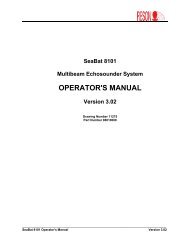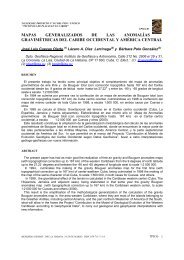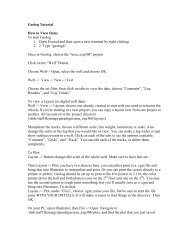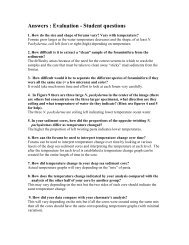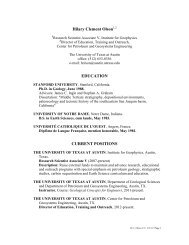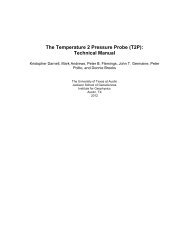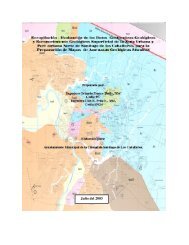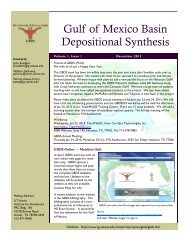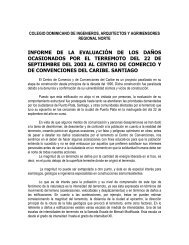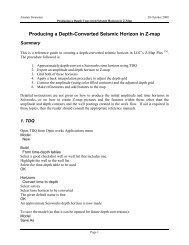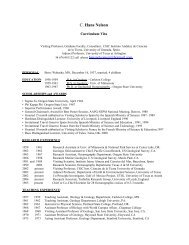IGCP Project short title: Caribbean Plate Tectonics Duration and ...
IGCP Project short title: Caribbean Plate Tectonics Duration and ...
IGCP Project short title: Caribbean Plate Tectonics Duration and ...
You also want an ePaper? Increase the reach of your titles
YUMPU automatically turns print PDFs into web optimized ePapers that Google loves.
24<br />
For this reason, during informal conversations during the meeting, we agree that the<br />
<strong>IGCP</strong>-433 annual session to be celebrated during the forthcomming <strong>Caribbean</strong> Geological<br />
Congress in Barbados (June, 2002), must focus in three main issues: 1) The Early Mesozoic<br />
evolution of the <strong>Caribbean</strong>, 2) The Early Tertiaty Evolution of the <strong>Caribbean</strong>, <strong>and</strong> 3) The<br />
interactions between the <strong>Caribbean</strong> <strong>Plate</strong> <strong>and</strong> South America.<br />
Abstracts of the <strong>IGCP</strong> <strong>Project</strong> 433-<strong>Caribbean</strong> <strong>Plate</strong> <strong>Tectonics</strong> Presented at the GSA Annual<br />
Meeting in Boston<br />
EVOLUTION OF THE NORTHERN PORTION OF THE CARIBBEAN PLATE: PACIFIC<br />
ORIGIN TO BAHAMIAN COLLISION<br />
PINDELL, James, DRAPER, Grenville, KENNAN, Lorcan, STANEK, Klaus P., <strong>and</strong><br />
MARESCH, Walter V.<br />
Pacific origin models of <strong>Caribbean</strong> are more compatible with regional <strong>Caribbean</strong><br />
geology than Intra-American models because (1) the Greater Antilles Arc (GAA) is older<br />
than the Central American Arc, which is predicted by Pacific, but not by Intra-American<br />
models; <strong>and</strong> (2) <strong>Caribbean</strong> tectonic interaction with northern Colombia <strong>and</strong> southern<br />
Yucatan began in the Campanian, which requires a more southwestward (Pacific) position of<br />
the <strong>Caribbean</strong> <strong>Plate</strong> before that time. We have refined earlier Pacific-derived <strong>Caribbean</strong><br />
evolutionary models to new levels of precision <strong>and</strong> conclude: 1) the Galapagos Hotspot did<br />
not form the <strong>Caribbean</strong> plateau; 2) Early Cretaceous subduction dipped NE; 3) Panama-<br />
Costa Rica arc formed at equatorial latitudes; 4) <strong>Caribbean</strong> HP/LT metamorphic<br />
assemblages (except those of Jamaica) pertain to initiation <strong>and</strong> subsequent development of<br />
SW-dipping subduction beneath the GAA that followed an Aptian-early Albian subduction<br />
polarity reversal event; the new polarity then allowed the <strong>Caribbean</strong><br />
<strong>Plate</strong> to enter the inter-American realm during Upper Cretaceous-Cenozoic; 5) the central<br />
Cuban Arc comprises mainly forearc elements of the GAA, <strong>and</strong> Sierra Maestra is more<br />
representative of the GAA axis; 6) Campanian cessation of magmatism in central Cuba<br />
resulted from shallowing of subduction as the GAA approached southern Yucatan, 7) the<br />
Yucatan intra-arc basin formed in two phases: Maastrichtian –Paleocene NW-SE extension<br />
driven by slab rollback of Jurassic Proto-<strong>Caribbean</strong> lithosphere along eastern Yucatan, <strong>and</strong><br />
Early <strong>and</strong> Middle Eocene NNE extension driven by rollback of Proto-<strong>Caribbean</strong> crust<br />
toward the Bahamas, controlled by N-ward propagation of a NNE-trending east-Yucatan tear<br />
fault, during which western <strong>and</strong> northern Cuban terranes were accreted to the front of the<br />
central Cuban fore-arc; 8) Middle Eocene collision of all Cuban terranes with the Bahamas,<br />
<strong>and</strong> rapid uplift of the orogen after the detachment of the SW-dipping; 9) Eocene onset of<br />
Cayman Trough pull-apart as the <strong>Caribbean</strong> <strong>Plate</strong> began its well-known subsequent<br />
migration to its present position ;10) Oligocene transpression in Hispaniola <strong>and</strong> Puerto Rico<br />
which led to the ?Late Oligocene separation onset of separation of the Hispaniola arc<br />
assemblages from Oriente, Cuba.<br />
PHANEROZOIC TECTONIC EVOLUTION OF THE NORTH AMERICAN PLATE<br />
BOUNDARY IN CUBA<br />
ITURRALDE-VINENT, Manuel A.<br />
In the Cuban territory crops out Phanerozoic rocks that contain stratigraphic sections<br />
of both the Bahamas <strong>and</strong> Yucatan borderl<strong>and</strong>s of the North American continental margin.<br />
These sections can be subdivided into three tectonic stages as follow: 1. The Jurassic to<br />
latest Cretaceous passive margin stage, represented by siliciclastic <strong>and</strong> carbonate rocks<br />
sections that characterize the formation <strong>and</strong> early evolution of the <strong>Caribbean</strong> sea <strong>and</strong> its<br />
northern continental margin. This was a stage of extensional stress <strong>and</strong> evolution from<br />
intracontinental to open marine facies. 2. The to latest Eocene collisional margin stage,<br />
represented by forel<strong>and</strong> sediments with large amount of<br />
allochthonous materials (ophiolite <strong>and</strong> volcanic arc elements). During these stage took place<br />
strong compressional deformations. 3. The latest Eocene to Recent stage, characterized by<br />
24



